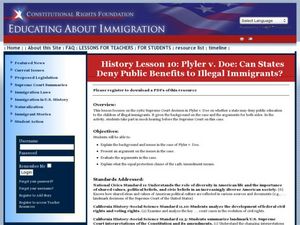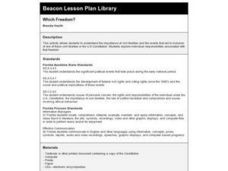Curated OER
Responsibilities and rights: Making civic decisions
Students, working in small groups, investigate concepts related to social and economic decision-making. They define issues for some different groups within Australia, then assign either government or individual responsibility for each...
Alabama Department of Archives and History
Alabama's 1901 Constitution: What Was at Stake?
Who should be able to vote? As part of a study of the 1901 Alabama Constitution, class members examine primary source document that reveal the reasons the authors gave to support their positions on this question and their assumptions in...
Curated OER
Electoral Process and Political Leadership
Young scholars analyze voting issues. In this Bill of Rights lesson, students read articles regarding the election of 1824, government in ancient Rome, and lack of voter participation. Young scholars discuss their impressions...
Curated OER
U.S. Constitution - Selecting the President
Young scholars study how the electoral college works to select a U.S. President. In this history lesson, students examine the U.S. Elector College methods then answer questions and write an essay that relate to the state where they...
Curated OER
How to Be a Good Citizen
In this citizenship worksheet, students learn about what it means to be a good citizen. They then answer the 20 questions on the worksheet. The answers are on the last page.
Curated OER
Keeping A Watchful Eye
Students explore the use of satellite surveillance systems to track criminals. They consider how the use of this technology in law enforcement might affect them and write opinions on whether or not such a system should be adopted by...
Curated OER
U. S. Constitution - Elections and Terms in Office
Students explore American elections and terms in office. In this U.S. government lesson, students respond to questions about voting rights. Students then write position papers on the existence of the Electoral College.
Curated OER
History Lesson 10: Plyler v. Doe: Can States Deny Public Benefits to Illegal Immigrants?
Students consider the rights of illegal immigrants. In this illegal immigration lesson, students analyze the Supreme Court case Plyler v. Doe and determine whether illegal immigrants should have access to public benefits. Students...
Curated OER
The ABCs of Citizenship
In this instructional activity, students read the book that focuses on the ascpects of citizenship/ Students imagine a scene in which each statement is actually happening. Students descirbe rights, repsonisbilities. Assess students by...
Curated OER
Women Today: An Editorial
Young scholars complete Internet research to write an editorial about a topic relating to the women's rights movement and the issues presently surrounding women's rights in America and around the world.
Curated OER
Motor Voter Registration Trends
Students read an article about new voter registration trends throughout the country. In groups, they identify new patterns when it comes to registering to vote and develop their own solutions to get more people registered. They present...
Curated OER
Change: Just a Matter of Time
Young scholars analyze the Declaration of Independence and primary sources to explain civil rights. Then, students write a Declaration of Change to express the grievances of African Americans, and their desire to participate fully in the...
Curated OER
Which Freedom?
Fourth graders choose on the freedoms in the Bill of Rights and research it on the internet. They answer specific questions using their research and produce a written document using a computer.
Curated OER
Confict, Consensus, and Conclusion
High schoolers debate the key issues dealing with women's rights and the rights of African Americans during and after the Civil War. They analyze the women's rights movement in relationship to the desire for suffrage. They utilize the...
Curated OER
Cartoons for the Classroom: The Veepstakes!
Take a step back in time with this political cartoon analysis worksheet, which features editorial cartoons from the 2008 presidential campaign. Background information allows pupils to "read between the lines" in their analysis, and three...
iCivics
Drafting Board: Electoral College
Should the president of the United States be voted by the Electoral College or the popular vote? Your young historians will consider the pros and cons of the Electoral College, and make an argument using reasons and evidence...
Roy Rosenzweig Center for History and New Media
Founding Documents
Teach the class about the predecessor to Declaration of Independence—the Virginia Declaration of Rights. Using the foundational documents, scholars examine the two writings to consider how they are similar and how they are different. A...
Curated OER
Civics Test for Citizenship: History and Government (51-100)
Use this presentation to help English learners prepare for their upcoming citizenship test. It includes questions 51-100 from the History and Government section of the exam (questions 1-50 can be found in a different presentation, linked...
Constitutional Rights Foundation
Educating About Immigration The DREAM Act
Group members role play state legislators, supporters of and opponents to the The DREAM Act (Development, Relief, and Education for Alien Minors). After listening to the arguments put forth for and against the immigration...
Read Works
The United States Constitution
The US Constitution is the beginning of Americans' rights. Use a five-paragraph passage to give a brief history of the US Constitution. A great last minute addition to a lesson on Constitution Day.
Smithsonian Institution
The Suffragist: Educator's Guide for Classroom Video
Class members take on the role of historical investigators to determine why it took 40 years for women in the United States to get the right to vote. Sleuths view videos and analyze primary sources and images to gather evidence to answer...
Curated OER
What does it mean to be a citizen?
Students examine democracy and the role of a citizen. They contrast rights and responsibilities of individuals, groups, and organizations. Students identify two forms of democratic action and describe demoncratic values. Students observe...
Curated OER
Revising The Constitution
Student review the Constitution using Dataviewer. Students discuss each Amendment in the Bill off rights and what each one means to individuals and their freedoms. Students break into groups and brainstorm about Amendments they think...
Curated OER
Fighting Political Apathy Among Youth
Students research and describe youth participation in political elections. They survey random adults about their voting behavior and chart the results in a graph. They compile their results to predict future voter participation.
Other popular searches
- Voting Rights Movement
- Voting Rights Act
- 1965 Voting Rights
- Minority Rights and Voting
- America and Voting Rights
- America Voting Rights
- Voting Rights Act 1965
- Voting Rights History
- Voting Rights Act of 1965
- Expanding Voting Rights
- Voting Rights of Women
- History of Voting Rights























